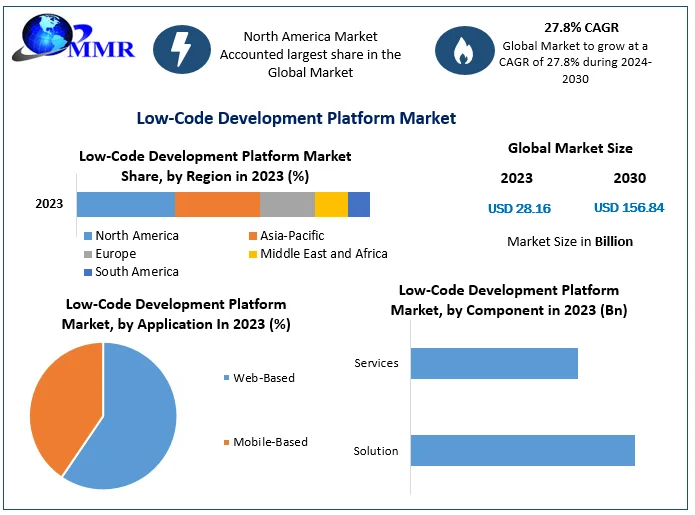Visual Development Environment :
Drag-and-Drop Interfaces: Low-code platforms provide visual tools for designing applications. Developers can easily build applications using drag-and-drop components without writing code.
Many low-code platform come with prebuilt templates and components. This lets developers quickly prototype or build applications, without having start from scratch.
Reduction of Coding Requirements
Automated Code Generating: Low-code platform automatically generates the code underneath based upon the visual models that developers create. This removes the need to write the code manually and speed up the process of development.
Reusable Components: Developers can reuse components from various projects to cut down on the time spent writing and testing code.
Collaboration can be made easier.
Low-code development platforms are usually equipped with tools such as deployment control, version control and testing. This allows seamless collaboration between teams.
Citizen Development: Users of businesses as well as non-developers can help with the development of applications using simple interfaces, which can reduce the bottleneck often caused by limited availability of professionals.
Rapid Iteration and Prototyping:
Rapid Prototyping: Developers design prototypes in a short time to validate ideas and gather feedback. This leads to faster iteration cycles.
Easy Modifications: The visual nature of low-code development makes it easier to make updates and changes to applications, which accelerates the process of improving and refining applications based on feedback from users.
Pre-built Integrations:
API Integrations. Low-code platforms typically have pre-built connectors and APIs for the most popular services that reduce the time needed to integrate with other systems.
Data Integration: The integrated tools facilitate the process of connecting to databases and other sources, accelerating development.
Deployment Scaling
One-Click Deployment: Many low-code platforms provide one-click deployment, greatly cutting down on the time and effort needed to deploy applications.
Cloud-based Solutions: Cloud platforms with low-code let developers focus on the functionality and logic of their applications instead of worrying about logistics for deployment.
Overall, the advantage of low-code application development in terms of speed lies in its ability to simplify and automate many elements of the process, which allows for faster delivery of applications and quicker adaptation to changing requirements. Have a look at the recommended Low-code Platform for application development blog for blog info including lowcode no code, database in azure, push notifications, cross platform app development, ms azure sql, app platforms, driver jdbc, push notifications, rapid action development, app dev platform and more.

Advantages Of Low Code Application Development For Governance And Security
Low-code design of applications offers a variety of advantages when it comes to governance and security. Both are crucial for ensuring that applications are in compliance, safe and well-managed throughout their entire life cycle. These are the benefits of developing applications using low-code:
Unified Management Console: Low-code platform often provides a centralized dashboard where administrators can oversee and manage all applications and ensure that the governance is consistent across the entire organization.
Role-Based Access Control: These platforms have robust control based on roles that allows administrators to define policies and then enforce these policies. This guarantees that only users who are authorized can access or modify specific areas of the application.
Compliance and Regulatory Conformity:
Features of compliance: Many platforms using low-code have been constructed to comply to industry standards. They provide templates and tools to ensure that applications comply with these requirements.
Audit Trails and Logging: Comprehensive logging and audit trails are often combined, allowing businesses to monitor changes, track access and ensure compliance with internal and external rules and regulations.
Enhance Security Measures
Data encryption: Low-code platforms generally provide encryption built-in for data that is in storage and in transit, ensuring that data sensitive information is secured.
Security Certifications: Many companies of low-code services have security certificates like ISO 27001 or SOC 2 to prove that they adhere to high standards. These certifications provide further assurance to users.
Automated updates for security:
Regular Patching and Updating Lowcode platforms generally manage regular updates to security. These patches guard software from the latest threats without requiring the involvement of developers.
Security Monitoring Tools: Tools for constant security monitoring are available. They offer real-time alerts as well as insights into possible security issues.
Data Governance:
Data Access Policies: These software tools enable organizations to define, enforce and monitor data policies. This will ensure that the information is only available to authorized users and are used in a proper manner.
Data Masking and Anonymization: Built-in tools for data masking and anonymization help protect sensitive information, especially in development and testing environments.
Consistent Application Lifecycle Management:
Pipelines for Development and Delivery: Low-code platform often include integrated development pipelines as well as delivery pipelines that incorporate security tests. Security is ensured throughout the entire lifecycle.
Version Control: An integrated version control system can help manage changes, allowing any modifications made to an application to be monitored. If required, these can be reverted and the integrity of the application maintained.
User Authentication and Authorization:
Single Sign-On (SSO): Support for single sign-on and other advanced authentication techniques simplifies user management and enhances security.
Multi-Factor Authentication Numerous platforms support multi-factor Authentication that adds an additional layer of security when logging into applications.
Policy Enforcement Monitoring and Compliance:
Low-code platforms are often already pre-defined with templates for policies to help organizations implement security and governance policies swiftly.
Tools for Monitoring Compliance: These instruments offer continuous monitoring, reporting and analysis of compliance status. It is easier to detect potential problems and take actions.
Integration with Existing Security Infrastructure
Seamless integration: Low-code platforms are able to be seamlessly integrated with existing security tools and systems like firewalls, SIEM solutions (Security Information and Event Management), and identity management systems.
API Security: API features which protect data and maintain the integrity of applications are built into the API.
Training and Best Practices:
Good practices: Several platforms have guidelines for developing secure applications and provide best practices. This can help non-developers comply with security standards.
Security Training: Some companies of low-code offer education and resources in security to help users learn how to build and maintain secure applications.
The security and governance capabilities of low-code apps ensure they are developed and maintained in a compliant and controlled way. These platforms provide the frameworks and tools necessary to safeguard sensitive data, enforce policies and maintain regulatory compliance while simplifying management and oversight. See the recommended read more here for Legacy application modernization with Low-code for website advice including low code platforms, database in azure, mobile app development platforms, build with docker, application modernization software, rad development, database in azure, azure sql, rad application development, app dev platform and more.

Benefits Of Low-Code Application Development With Regard To Customization And Limitations
Low-code applications are an equilibrative, flexible method that addresses issues and permits customization. These are the main benefits: Handling Limitations:
Overcoming Complexity Barriers
Low-code platforms make development easier by providing templates that are pre-built and components. This allows quicker deployment and the development of more complex applications.
Guided Workflows: Several platforms have guided workflows as well as wizards to assist developers in navigating through the maze of processes, decreasing the likelihood of errors and guaranteeing consistency.
Scalability solutions:
Built-in Scalability: Low code platforms come with a variety of options that enable scalable architectural design, allowing applications to take on a greater loads without major redevelopment.
Performance Monitoring Performance Monitoring Tools: Integrated performance monitoring tools and optimization make sure that applications are as efficient as they can be, no matter their scale.
Security and Compliance:
Integrated Security Features: Low code platforms are equipped with security measures built in including encryption and role-based access controls. They also conduct automated checks of compliance to deal with security concerns.
Regular Updates: Platforms often upgrade their security protocols and compliance policies. This makes sure that applications remain protected against emerging threats.
Customization:
Extensibility:
Custom Code Integration: Low-code platforms often allow the integration of custom codes (e.g., JavaScript, Python) which allows developers to enhance the functionality beyond what is available in the standard features.
Custom Modules and Plugins: Developers have the option of designing custom modules or plugins in order to customize specific functionality to meet specific business requirements.
APIs and Integration
API Support: Comprehensive support for APIs allows seamless integration with other systems and services. This allows for customizing and connectivity.
Third-Party Applications Lowcode platforms usually come built with connectors for third-party applications. This makes it easier to integrate them and modify the app.
Flexible Design for UI/UX
User interfaces that can be customized: Developers can alter and design user interfaces in order to fulfill specific branding requirements as well as usability needs, providing a tailored experience for users.
Responsive Design: The apps can be adapted to fit different sizes of screens and devices.
The process of customizing Business Logic is easy:
Visual Workflow Builds: Visual tools that permit the modification of business workflows and rules and to design complex customized procedures.
Platforms include conditional Logic, which allows for the creation of custom scripts that address specific scenarios and business rules.
Data Management
Custom Data models: Developers have the ability to design a custom data model to satisfy specific requirements of an application, and ensure that data handling meets business requirements.
Advanced Data Processor: The combination of advanced data processing tools and capabilities permits the customization of how data is analysed and used in the application.
Customisation and balancing limits:
Frameworks and Standards
Low-code Platforms Support Industry Best Practices and Standards: Low code platforms encourage the adherence of the industry's best standards and practices. This helps to maintain top-quality, secure, and flexible applications.
Governance Frameworks: Built-in governance frameworks ensure that customizations do not affect the security, integrity or security of the software.
Iterative Development:
Rapid Prototyping: The ability to quickly prototype and test changes allows developers to modify their designs based on feedback from users improving the app to better satisfy the user's needs.
Continuous Improvement: Platforms using low-code enable continuous improvement, allowing customization and enhancement when the requirements of business change.
User Empowerment
Empowering Citizen developers: Low-code interfaces that are intuitive allow non-developers to modify the application. This can increase the number of contributors able to improve and customize applications.
Support and Training: Many platforms have extensive resources for training and support to assist users to make effective modifications, without compromising application stability or performance.
Low-code development is a powerful framework that offers a wide range of flexibility while also addressing shortcomings. This balance allows companies to develop and maintain applications that function and adapted to meet specific business requirements. While keeping high-quality, security as well as scalability and standards.
